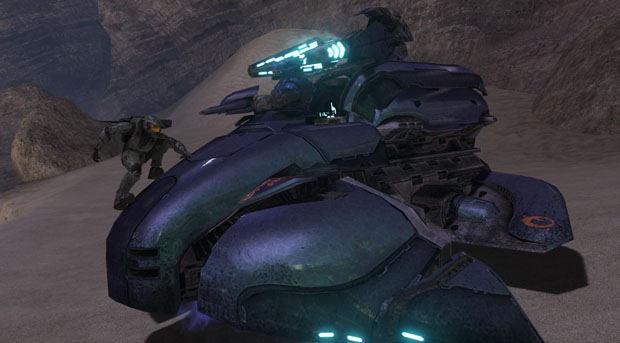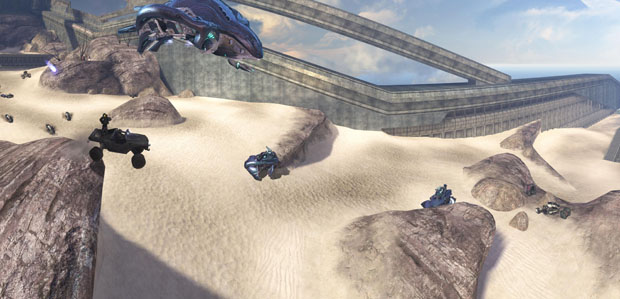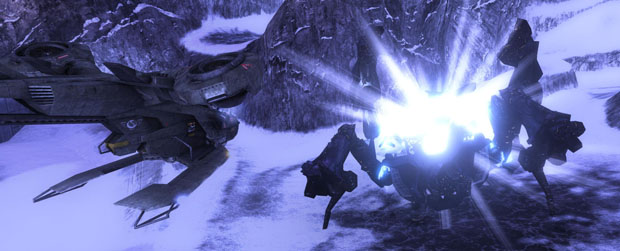Sandbox (Part Two)

Implements of War
Although the evolution of the Halo sandbox may seem healthy and logical on paper, the best way to really understand why its quality can directly impact the overall entertainment value of an encounter is through first-hand experience. Since we can’t readily give you a controller and load up a mission whilst reading this piece, we’ll take you there…
![]()
In pursuit of the Scarab, the player emerges from the vast tunnel system of Halo 2’s Metropolis, and into a large amphitheater-like reservoir. Immediately, they come upon an unaware Jackal sniper. Their first move is inevitably to assassinate this threat, and as soon as this is done, an encounter of considerable scale is sparked.
Waves of sniper reinforcements move in sequence onto a nearby platform, trying to get a bead on you, as a group of Elites and Grunts prepare turret emplacements to support them. In the far corner of the structure, a handful of Ghosts lay siege to a lone Marine and his Gauss Warthog. The soldier escapes momentarily and pulls around to offer you ride.
Here, you’re presented with the clear choice to do one of several things: take the wheel of the Warthog, take its Gauss Cannon or head out on foot. While the first two are definitely gratifying, the third will open up even more possibilities. Channeling around the left side of the amphitheater gives you access to the snipers’ perch and with the assistance of the first Jackal’s Beam Rifle (or a nearby Sniper Rifle), you can deal with the remaining foes individually. The infantry and the Ghosts, at first preoccupied with the UNSC vehicle, will typically turn their attention to you when the Marine is finally overwhelmed. Moving quickly down a spindly series of platforms, you can save him by quickly eliminating the infantry and using the turrets against the Ghosts, or better yet, board one of them and turn it against your enemies.
Whether you leave this area with the Gauss Hog, a Ghost or on foot, the player is immediately submerged into yet another encounter, this one in a larger extension of the same reservoir. A considerable amount of Ghosts, escorted by a Wraith and a couple Jackal snipers await your approach. Many players may be inclined to rush the Wraith, board it and then use it for their own violent measures, decimating the entrenched Covenant one mortar at a time. That being said, however, there are at least half a dozen (if not more) distinctively different sandbox choices at your disposal in this single area.
The end cap to this series of encounters is on the other side of a wall, where the player finally arrives in downtown Mombasa, underneath the shadows of a skyscraper-filled landscape. Warthogs are already engaged with Ghosts and the player can once again climb aboard or head out on foot. With more Jackal snipers and a pair of Wraiths forming a blockade at the end of the street, the player has a sizeable list of strategies at their disposal. While this encounter’s locale may seem stifled and narrow compared to Halo: Combat Evolved’s sprawling terrain, the sandbox is far broader and clearly more intensive.
In fact, the sandbox is so strong in Halo 2’s campaign that, at several points throughout the game, a mission will simply offer the player a cache of weapons in all shapes and sizes - seemingly in an effort to overtly lessen the restrictiveness of the levels’ somewhat linear design. Although Halo: Combat Evolved mastered environments and spatial combat, the sandbox’s improvements surged through Halo 2. Systematically, through both lauded and controversial changes, we received Halo 3 - wherein we have the fulfillment of the series’ sandbox at the highest order.

The heavy vehicle run on Halo 3’s “The Ark” is easily the most massive series of encounters in the entire trilogy - this is largely due to the dramatic and unfettered use of the sandbox.
What are possibly the most prominent examples of a sandbox’s impact are the Scarab battles of Halo 3. There are three separate encounters which involve a Scarab or Scarabs in the game, but even in the first and most simplified one, the choices offered by the diverse and corpulent sandbox are astounding. Once the area’s Wraiths and Ghosts are clear in Halo 3’s The Storm, a Scarab appears, lumbering nimbly over Voi’s dockside warehouse and directly onto the battlefield.
When the initial sense of awe has worn off, players have a veritable cornucopia of choices at their fingertips - all offered thanks to the environment’s proper coordination with Halo 3’s sandbox. They can take the fight to the Scarab on the ground, dangerously shuffling about underneath its belly and issuing pot shots at its legs till the vessel momentarily drops. They can also use nearby Mongooses or Ghosts to the same end, but, perhaps, at a quicker and more risky pace.
At a distance, the player can even choose to assault the enemies on the Scarab’s platforms with a ranged weapon or by taking hold of the nearby Missile Pod, which can also immobilize the Scarab by knocking out one of its legs. Although some success might be had from afar against the protected energy core which powers the Scarab, most encounters typically result in the player being required to board the vehicle and take the fight directly to the Covenant. There, they could use a close-quarters weapons or even one of the mounted turret emplacements to deplete the wealth of enemy troops clamoring about, above and within. Finally destroying the core at the rear of craft ends the Scarab’s reign of terror, but the options you have to get this done are nothing short of immense.
Even with this first Scarab encounter, the player might feel inundated with the choices, but it pales in comparison to the encounters which follow - encounters that offer the player Scorpion Tanks, Choppers, Gauss Hogs and even Hornets, as well as the ability to jettison off of nearby structures and onto the Scarab with the use of an anti-gravity pad from the equipment class. Overall, the Scarab encounters are just a portion of the tapestry in the trilogy’s campaigns when it comes to the employment of Halo’s sandbox. When you look at the myriad of encounters over the whole of the series, you’ll inevitably find that a sandbox’s proper evolution and implementation are the heart and soul of each encounter.
Keys to the Castle
So the questions are invariably offered: What is so special about Halo’s sandbox? What did Bungie get right and how did they get it right? What makes a sandbox compelling and, for lack of a better word, good?
There are actually four specific reasons why the Halo sandbox has been successful and why, in many respects, it continues to trump the sandboxes of other shooters both in versatility and utility. Here they are:
- Halo’s sandbox is diversely dense. With a few exceptions, the sandbox of Halo is not only massive, but it yields an extremely distinct variety. Many shooters have large sandboxes with dozens of weapons and vehicles, but not without sizeable redundancy. Even at the culmination of the trilogy’s sandbox, Halo 3 continually delivers an incredibly rich amount of tools - each providing their own variety of combat which is both different and interesting from all of the others.
- Halo’s sandbox has character. Although the story of Halo is typically only enjoyed by serious fans, casual ones still reap the benefits. Whether we’re talking about the intriguingly primitive architecture of the Brute Chopper or the visually striking effects of a Needler’s death toll, the implements of war in Halo are both amazing and beautiful. They adhere to the story with staunch accuracy and seem to function in a manner which is wholly plausible. This visual style of being battered and authentic is something that few other franchises have pulled off successfully - the most popular, of course, being Star Wars. Using these implements, you easily feel as though you’re a part of the Master Chief’s story and a part of the Halo universe.
- Halo’s sandbox is experientially satisfying. There are very few gaming feelings which rival the gratification offered by successfully implementing Halo’s sandbox against enemies in campaign. Sticking a Brute’s face with a Spike Grenade, only to kill both him and his flanking ally, is rewarding on many levels, just as rewarding as punching hole after hole through an oncoming Phantom dropship with your Scorpion Tank, destroying both it, its passengers and the Wraith which it intended to use against you. The thrill of launching a vehicle headlong into a crowd of enemies or climbing a ridge to snipe the dozens of targets below have been attempted in other games with minimal success. Halo does it with relative ease and elegance.
- Halo’s sandbox is balanced in campaign. Halo 3, the full realization of the trilogy’s sandbox, also offers an incredible amount of balance. Before facing a difficult Chieftain at the end of a mission chapter, for example, players are sometimes given an opportunity to gain active camouflage, a piece of equipment which gives them temporary invisibility. To acquire it, they’re usually forced to battle an enemy or series of enemies. The reward is obvious - the Chieftain encounter will be easier, but the road to that simplification is not as easy. Another historical example across the trilogy is that players are given rocket launchers at the various Pelican crash sites - a distinctive balancing measure which likely proceeds a vehicle-heavy affair. Not only does this make an encounter more balanced, but it makes it rewarding and challenging - two crucial attributes, which, when absent throw the game’s encounters into disarray and obsolescence.
While we know that the sandboxes which Halo 2 and Halo 3 utilized were not perfect, they clearly set the bar for many games which have followed. As indicated above, they do many things right. In any given encounter, a player has a litany of weapons, vehicles and choices at their disposal. This, functioning hand-in-hand with an environment, set the stage for an amazing experience.

The only remaining piece to this puzzle, of course, are the enemies…